The Harveys were a distinguished local family, many of whom are buried at nearby Hempstead. Among them is Sir Eliab Harvey who commanded the Temeraire at Trafalgar in 1805. He had a distinguished naval career. During the famous naval encounter, the ship was second in line to Nelson’s flagship HMS Victory. The Temeraire was later immortalised in a painting by the celebrated artist JMW Turner and is also recalled in the name of this Wetherspoon pub.
Photographs, illustrations and text about Samuel Herbert Dougal.
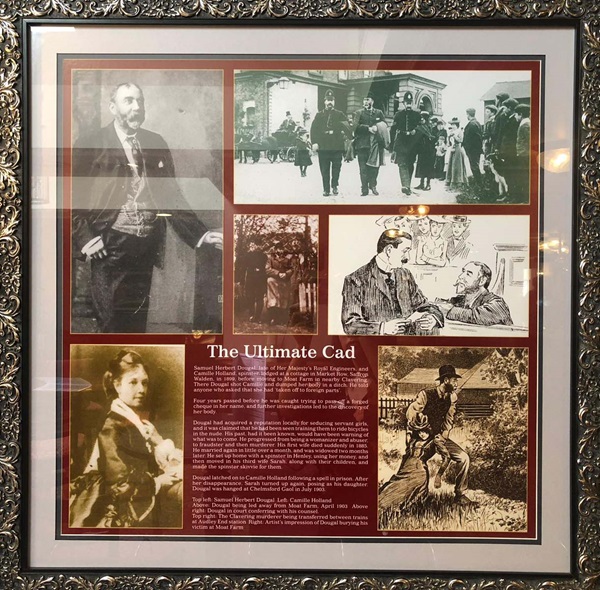
The text reads: Samuel Herbert Dougal, late of Her Majesty’s Royal Engineers, and Camille Holland, spinster, lodged at a cottage in Market Row, Saffron Walden, in 1899, before moving to Moat Farm in nearby Clavering. There Dougal shot Camille and dumped her body in a ditch. He told anyone who asked that she had ‘taken off to foreign parts’.
Four years passed before he was caught trying to pass off a forged cheque in her name, and further investigations led to the discovery of her body.
Dougal had acquired a reputation locally for seducing servant girls, and it was claimed that he has been seen training them to ride bicycles in the nude. His past, had it been known, would have been warning of what was to come. He progressed from being a womanizer and abuser, to fraudster and then murderer. His first wife died suddenly in 1885. He married again a little over a month, and was widowed to months later. He set up home with a spinster in Henley, using her money, and then moved in his third wife Sarah, along with their children, and made the spinster skivvie for them.
Dougal latched on to Camille Holland following a spell in prison. After her disappearance, Sarah turned up again, posing as his daughter. Dougal was hanged at Chelmsford Gaol in July 1903.
Top left: Samuel Herbert Dougal
Left: Camille Holland
Above: Dougal being led away from Moat Farm, April 1903
Above right: Dougal in court conferring with his counsel
Top right: The Clavering murderer being transferred between trains at Audley End Station
Right: Artist’s impression of Dougal burying his victim at Moat Farm.
Text about Henry Winstanley.
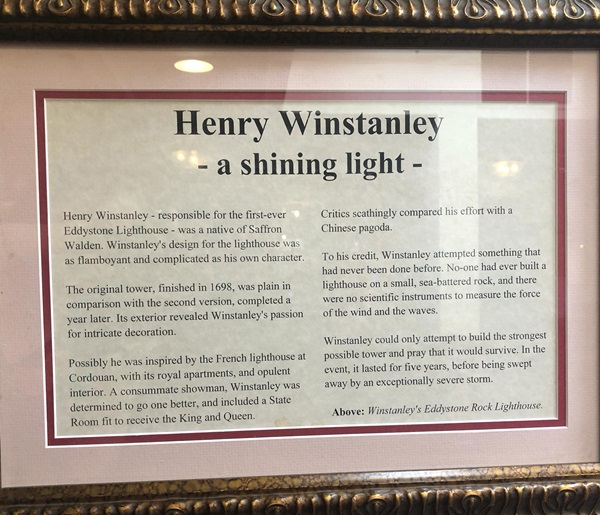
The text reads: Henry Winstanley – responsible for the first-ever Eddystone Lighthouse – was a native of Saffron Walden. Winstanley’s design for the lighthouse was as flamboyant and complicated as his own character.
The original tower, finished in 1698, was plain in comparison with the second version, completed a year later. Its exterior revealed Winstanley’s passion for intricate decoration.
Possibly he was inspired by the French lighthouse at Cordouan, with its royal apartments, and opulent interior. A consummate showman, Winstanley was determined to go one better, and include a State Room fit to receive the King and Queen.
Critics scathingly compared his effort with a Chinese pagoda.
To his credit, Winstanley attempted something that had never been done before. No-one had ever built a lighthouse on a small, sea-battered rock, and there were no scientific instruments to measure the force of the wind and the waves.
Winstanley could only attempt to build the strongest possible tower and pray that it would survive. In the event, it lasted for five years, before being swept away by an exceptionally severe storm.
Text about 55 High Street.
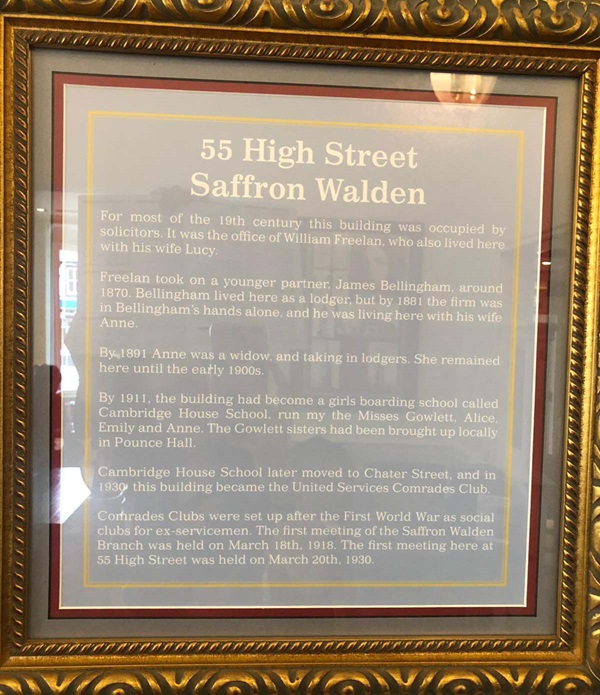
The text reads: For most of the 19th century this building was occupied by solicitors. It was the office of William Freelan, who also lived here with his wife Lucy.
Freelan took on a younger partner, James Bellingham, around 1870. Bellingham’s hands alone, and he was living here with his wife Anne.
By 1891 Anne was a widow, and taking in lodgers. She remained here until the early 1900s.
By 1911, the building had become a girls boarding school called Cambridge House School, run by the Misses Gowlett, Alice, Emily and Anne. The Gowlett sisters had been brought up locally in Pounce Hall.
Cambridge House School later moved to Chater Street, and in 1930 this building became the United Services Comrades Club.
Comrades Clubs were set up after the First World War as social clubs for ex-servicemen. The first meeting of the Saffron Walden Branch was held on March 18. The first meeting here at 55 High Street was held on March 20, 1930.
Photographs and text about Richard Austen Butler.
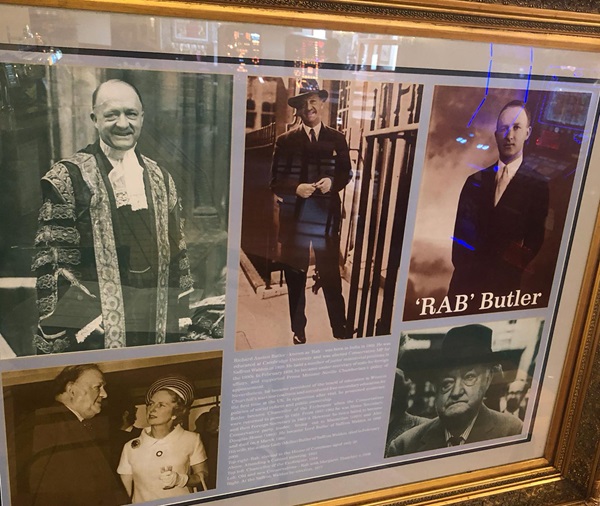
The text reads: Richard Austen Butler – known as ‘Rab’ – was born in India in 1902. He was educated at Cambridge University and was elected Conservative MP for Saffron Walden in 1929. He held a number of junior ministerial positions in the 1930s. In February 1938, he became under-secretary of state for foreign affairs, and supported prime minister Neville Chamberlain’s policy of appeasement.
Nevertheless, he became president of the board of education in Winston Churchill’s wartime coalition and introduced free education in Winston Churchill’s wartime coalition and introduced free secondary education for the first time in the UK. In opposition after 1945, he promoted moderate policies of social reform and public ownership.
Butler became chancellor of the exchequer when the Conservatives were returned to power in 1951. From 1957-1962 he was Home Secretary, and then Foreign Secretary in 1963-4. However, he twice failed to become Conservative party leader, losing out to Macmillan (1957) and Alec Douglas-Home (1963). He became Lord Butler of Saffron Walden in 1965 and died on 8 March 1982.
His wife, the author Lady (Mollie) Butler of Saffron Walden, died in February 2009.
Top right: Rab, elected to the House of Commons aged only 26
Above: Attending a Cabinet meeting, 1953
Top left: Chancellor of the Exchequer, 1954
Left: Old and new Conservatives – Rab with Margaret Thatcher, c1980
Right: At the Saffron Walden by-election, 1977.
Text about the painting The Fighting Temeraire.
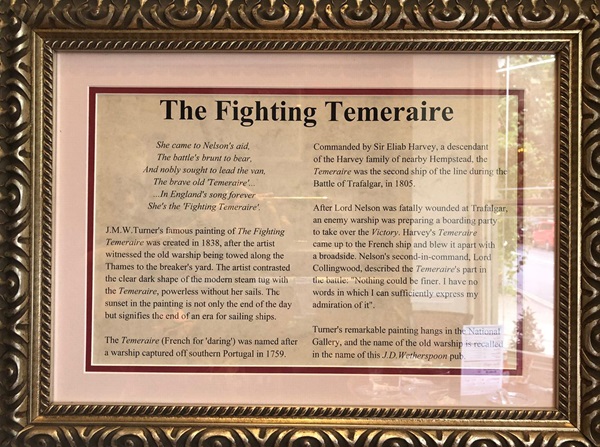
The text reads: She came to Nelson’s aid,
The battle’s brunt to bear,
And nobly sought to lead the van,
The brave old Temeraire’…
…In England’s song forever
She’s the ‘Fighting Temeraire’.
JMW Turner’s famous painting of The Fighting Temeraire was created in 1838, after the artist witnessed the old warship being towed along the Thames to the breaker’s yard. The artist contrasted the clear dark shape of the modern steam tug with the Temeraire, powerless without her sails. The sunset in the painting is not only the end of the day but signifies the end of an era for sailing ships.
The Temeraire (French for ‘daring’) was named after a warship captured off southern Portugal in 1759.
Commanded by Sir Eliab Harvey, a descendant of the Harvey family of nearby Hempstead, the Temeraire was the second ship of the line during the Battle of Trafalgar, in 1805.
After Lord Nelson was fatally wounded at Trafalgar, an enemy warship was preparing a boarding party to take over the Victory. Harvey’s Temeraire came up to the French ship and blew it apart with a broadside. Nelson’s second-in-command, Lord Collingwood, described the Temeraire’s part in the battle: “Nothing could be finer. I have no words in which I can sufficiently express my admiration of it”.
Turner’s remarkable painting hangs in the National Gallery, and the name of the old warship is recalled in the name of this J D Wetherspoon pub.
Old photographs of Saffron Walden.
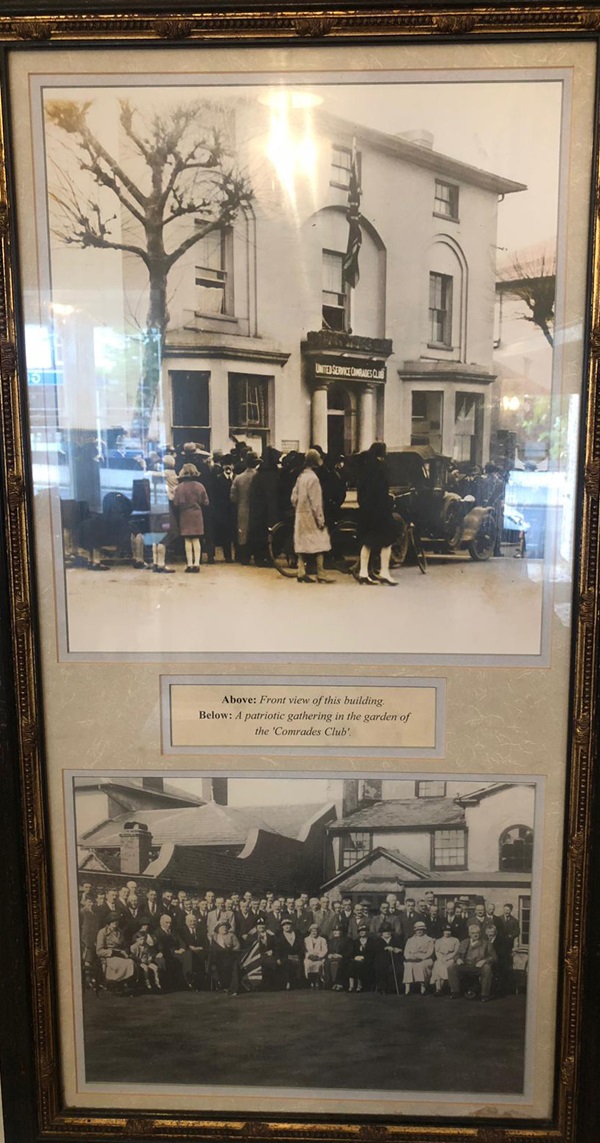
Above: Front view of this building
Below: A patriotic gathering in the garden of the ‘Comrades Club’.
External photograph of the building – main entrance.
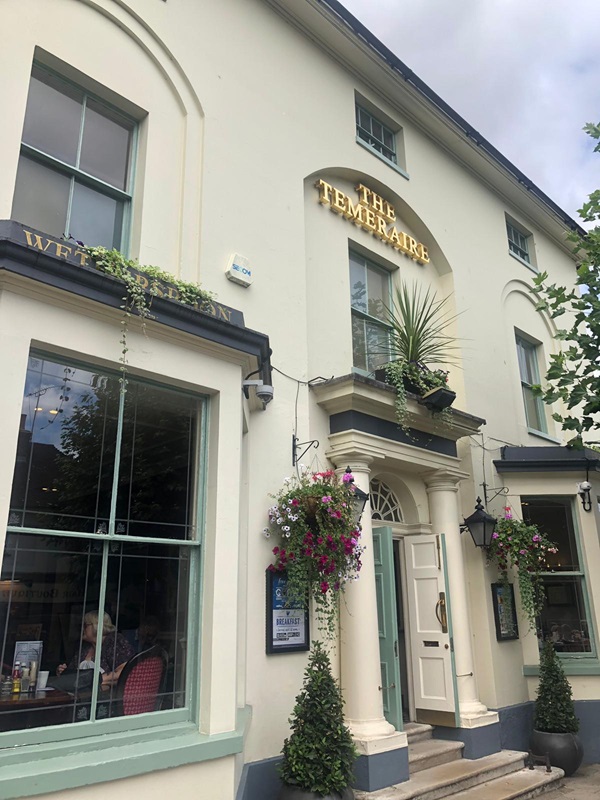
If you have information on the history of this pub, then we’d like you to share it with us. Please e-mail all information to: pubhistories@jdwetherspoon.co.uk